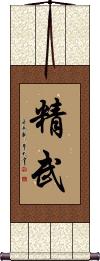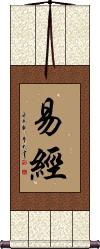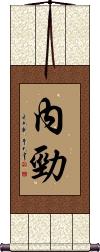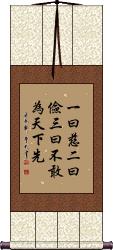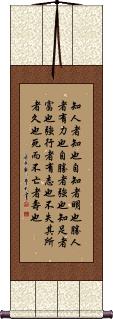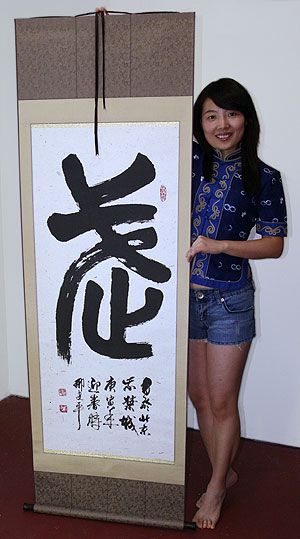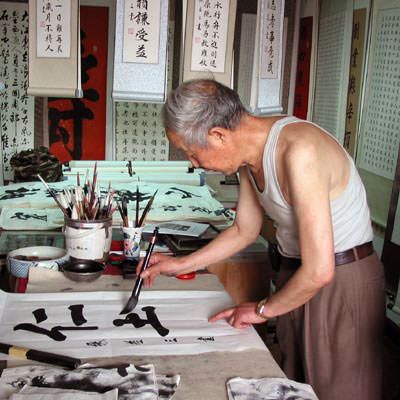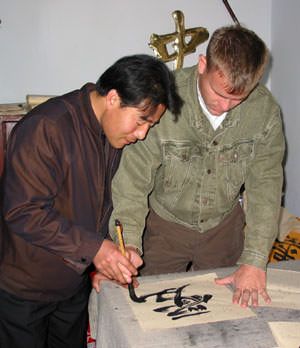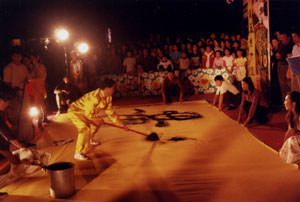Many custom options...
And formats...

Jing Mo in Chinese / Japanese...
Buy a Jing Mo calligraphy wall scroll here!
Personalize your custom “Jing Mo” project by clicking the button next to your favorite “Jing Mo” title below...
2. Three Treasures of Chinese Medicine
3. The Book of Changes / I Ching
4. Neijing
Jing Mo / Jing Wu
精武 is the title used for a certain type of martial arts. You can translate this roughly as “Excellent Martial Arts” or “Excellence in Martial Arts.” You will notice that the second character is “wu” as in wushu (martial arts) and wushi (warrior).
More information can be found at the Jing Mo website. You should probably only order this if you are a member of this association.
Note that “jing mo” is the Cantonese pronunciation of these characters. In Mandarin, they are “jing wu.”
Also used in Korean but only by those involved with martial arts who can also read Korean Hanja (a small percentage of the population).
Three Treasures of Chinese Medicine
精, 氣, 神 are the characters jing, qi, and shen.
As a set, these three characters are known in English as the treasures of traditional Chinese medicine, the treasures of Qi Gong, or the three treasures of Taoism / Daoism.
Sometimes this set is titled 三寶 (sānbǎo) or “three treasures,” but here, we're writing each treasure out.
Here's how these characters are perceived in this context...
Jing: nutritive essence; refined; perfected; pure
Qi: vitality; energy; force; breath; vigor
Shen: spirit; soul; mind; being
To keep it simple, you can use “essence, vitality, and spirit” to define these.
The Book of Changes / I Ching
Neijing
Mercy / Compassion / Love
慈 is the simplest way to express the idea of compassion.
This can also mean love for your fellow humans, humanity, or living creatures. Sometimes this is extended to mean charity.
This term is often used in a Buddhist or Christian context. The concept was also spoken of by Laozi (Lao Tzu) in the Dao De Jing (Tao Te Ching).
慈 is considered the direct translation of the Sanskrit word मैत्री (maitrī) Pali word मेत्ता (mettā). In this context, it means benevolence, loving kindness, and goodwill.
This Chinese character is understood in Japanese but is usually used in compound words (not seen alone). Also used in old Korean Hanja, so it's very universal.
See Also: Mercy | Benevolence | Forgiveness | Kindness
Daodejing / Tao Te Ching - Excerpt
Excerpt from Chapter 67
一曰慈二曰儉三曰不敢為天下先 is an excerpt from the 67th Chapter of Lao Tzu's (Lao Zi's) Te-Tao Ching (Dao De Jing).
This is the part where the three treasures are discussed. In English, we'd say these three treasures are compassion, frugality, and humility. Some may translate these as love, moderation, and lack of arrogance. I have also seen them translated as benevolence, modesty, and “Not presuming to be at the forefront in the world.” You can mix them up the way you want, as translation is not really a science but rather an art.
I should also explain that the first two treasures are single-character ideas, yet the third treasure was written out in six characters (there are also some auxiliary characters to number the treasures).
If Lao Tzu's words are important to you, then a wall scroll with this passage might make a great addition to your home.
Daodejing / Tao Te Ching - Chapter 33
This is referred to as passage or chapter 33 of the Dao De Jing (often Romanized as “Tao Te Ching”).
These are the words of the philosopher Laozi (Lao Tzu).
To know others is wisdom;
To know oneself is acuity/intelligence.
To conquer others is power,
To conquer oneself is strength.
To know contentment is to have wealth.
To act resolutely is to have purpose.
To stay one's ground is to be enduring.
To die and yet not be forgotten is to be long-lived.
To understand others is to be knowledgeable;
To understand yourself is to be wise.
To conquer others is to have strength;
To conquer yourself is to be strong.
To know when you have enough is to be rich.
To go forward with strength is to have ambition.
To not lose your place is to be long-lasting.
To die but not be forgotten -- that's true long life.
He who is content is rich;
He who acts with persistence has will;
He who does not lose his roots will endure;
He who dies physically but preserves the Dao
will enjoy a long after-life.
Notes:
During our research, the Chinese characters shown here are probably the most accurate to the original text of Laozi. These were taken for the most part from the Mawangdui 1973 and Guodan 1993 manuscripts which pre-date other Daodejing texts by about 1000 years.
Grammar was a little different in Laozi’s time. So you should consider this to be the ancient Chinese version. Some have modernized this passage by adding, removing, or swapping articles and changing the grammar (we felt the oldest and most original version would be more desirable). You may find other versions printed in books or online - sometimes these modern texts are simply used to explain to Chinese people what the original text really means.
This language issue can be compared in English by thinking how the King James (known as the Authorized version in Great Britain) Bible from 1611 was written, and comparing it to modern English. Now imagine that the Daodejing was probably written around 403 BCE (2000 years before the King James Version of the Bible). To a Chinese person, the original Daodejing reads like text that is 3 times more detached compared to Shakespeare’s English is to our modern-day speech.
Extended notes:
While on this Biblical text comparison, it should be noted, that just like the Bible, all the original texts of the Daodejing were lost or destroyed long ago. Just as with the scripture used to create the Bible, various manuscripts exist, many with variations or copyist errors. Just as the earliest New Testament scripture (incomplete) is from 170 years after Christ, the earliest Daodejing manuscript (incomplete) is from 100-200 years after the death of Laozi.
The reason that the originals were lost probably has a lot to do with the first Qin Emperor. Upon taking power and unifying China, he ordered the burning and destruction of all books (scrolls/rolls) except those pertaining to Chinese medicine and a few other subjects. The surviving Daodejing manuscripts were either hidden on purpose or simply forgotten about. Some were not unearthed until as late as 1993.
We compared a lot of research by various archeologists and historians before deciding on this as the most accurate and correct version. But one must allow that it may not be perfect, or the actual and original as from the hand of Laozi himself.
This in-stock artwork might be what you are looking for, and ships right away...
Gallery Price: $200.00
Your Price: $79.88
Not the results for jing mo that you were looking for?
Below are some entries from our dictionary that may match your jing mo search...
| Characters If shown, 2nd row is Simp. Chinese |
Pronunciation Romanization |
Simple Dictionary Definition |
風 风 see styles |
fēng feng1 feng fuwari ふわり |
More info & calligraphy: Wind(adj-na,n,n-suf) (1) method; manner; way; style; (adj-na,n,n-suf) (2) appearance; air; (adj-na,n,n-suf) (3) tendency; (adj-na,n,n-suf) (4) (See 六義・1) folk song (genre of the Shi Jing); (adj-na,n,n-suf) (5) (See 五大・1) wind (one of the five elements); (female given name) Fuwari vāyu. Wind, air; rumour, repute; custom; temper, lust. |
道德經 道德经 see styles |
dào dé jīng dao4 de2 jing1 tao te ching Dōtoku kyō |
More info & calligraphy: Daodejing / Tao Te ChingDaode jing |
比 see styles |
bǐ bi3 pi firipin ふぃりぴん |
to compare; (followed by a noun and adjective) more {adj.} than {noun}; ratio; to gesture; (Taiwan pr. [bi4] in some compounds derived from Classical Chinese) (n,n-suf) (1) ratio; proportion; (2) match; equal; equivalent; comparison; (suffix noun) (3) compared with ...; relative to ...; (4) (abbreviation) (See 比律賓・フィリピン) Philippines; (5) (See 六義・1) explicit comparison (style of the Shi Jing); (place-name) Firipin To compare; than; to assemble, arrive; partisan; each; translit. pi, bhi, vi, v. also 毘, 毗. |
涇 泾 see styles |
jīng jing1 ching |
Jing River |
興 兴 see styles |
xìng xing4 hsing hajime はじめ |
feeling or desire to do something; interest in something; excitement (1) interest; entertainment; pleasure; (2) (See 六義・1) implicit comparison (style of the Shi Jing); (given name) Hajime abhyudaya. Rise, begin; prosper; elated. |
賦 赋 see styles |
fù fu4 fu mitsugu みつぐ |
poetic essay; taxation; to bestow on; to endow with (1) poem; (2) (See 六義・1) narrative (style of the Shi Jing); (3) classical Chinese rhymed prose; (given name) Mitsugu |
雅 see styles |
yǎ ya3 ya moto もと |
elegant (noun or adjectival noun) (1) (ant: 俗・ぞく・4) elegance; grace; (2) (See 六義・1) festal song (genre of the Shi Jing); (personal name) Moto really |
ちん see styles |
chin チン |
jing (Korean gong) (kor:); (place-name) Chin (Burmah); Ching; Chinn; Zinn |
乳味 see styles |
rǔ wèi ru3 wei4 ju wei nyūmi |
The flavour of fresh milk, to which the Buddha's teaching in the 華嚴經 Huayan jing is compared. |
京族 see styles |
jīng zú jing1 zu2 ching tsu kinzoku キンぞく |
Gin or Jing, ethnic minority of China, descendants of ethnic Vietnamese people living mainly in Guangxi; Kinh, the ethnic majority in Vietnam Kinh (people); Vietnamese (people) |
六位 see styles |
liù wèi liu4 wei4 liu wei rokui |
The six stages of Bodhisattva development, i. e. 十信位; 十住位; 十廻向位; 十地位; 等覺位; 佛地位; these are from the order Huayan jing. |
六義 see styles |
rokugi ろくぎ |
(1) six forms of the Shi Jing (genre: folk song, festal song, hymn; style: narrative, explicit comparison, implicit comparison); (2) six forms of waka (allegorical, enumerative, metaphorical, allusive, plain, congratulatory); (3) six principles of calligraphy; (4) (See 六書・1) six classes of kanji characters; (given name) Rokugi |
大雅 see styles |
dà yǎ da4 ya3 ta ya hiromasa ひろまさ |
one of the three main divisions of the Book of Songs 詩經|诗经 (See 雅・2) major festal song (subgenre of the Shi Jing); (given name) Hiromasa |
宣紙 宣纸 see styles |
xuān zhǐ xuan1 zhi3 hsüan chih |
fine writing paper, originally from Jing county 涇縣|泾县, Xuancheng 宣城, Anhui |
小雅 see styles |
xiǎo yǎ xiao3 ya3 hsiao ya shouga / shoga しょうが |
one of the three main divisions of the Book of Songs 詩經|诗经 (See 雅・が・2) minor festal song (subgenre of the Shi Jing) |
徑山 径山 see styles |
jìng shān jing4 shan1 ching shan Kinzan |
A monastery at Linan Xian, Zhejiang. |
景怡 see styles |
keii / ke けいい |
(female given name) Keii; Jing Yi |
景縣 景县 see styles |
jǐng xiàn jing3 xian4 ching hsien |
Jing County or Jingxian, a county in Hengshui City 衡水市[Heng2 shui3 Shi4], Hebei |
李靖 see styles |
lǐ jìng li3 jing4 li ching risei / rise りせい |
Li Jing (570-649 AD), Tang Dynasty general and purported author of "Duke Li of Wei Answering Emperor Taizong of Tang" 唐太宗李衛公問對|唐太宗李卫公问对[Tang2 Tai4 zong1 Li3 Wei4 Gong1 Wen4 dui4], one of the Seven Military Classics of ancient China 武經七書|武经七书[Wu3 jing1 Qi1 shu1] (personal name) Risei |
涇縣 泾县 see styles |
jīng xiàn jing1 xian4 ching hsien |
Jing County or Jingxian, a county in Xuancheng City 宣城市[Xuan1 cheng2 Shi4], Anhui |
淨空 see styles |
jìng kōng jing4 kong1 ching k`ung ching kung Jō Kū |
Jing Kong |
澄嚴 澄严 see styles |
chéng yán cheng2 yan2 ch`eng yen cheng yen Chōgon |
Jing-eom |
精河 see styles |
jīng hé jing1 he2 ching ho |
Jing Nahiyisi or Jinghe county in Börtala Mongol autonomous prefecture 博爾塔拉蒙古自治州|博尔塔拉蒙古自治州, Xinjiang |
良賁 良贲 see styles |
liáng bēn liang2 ben1 liang pen Ryōbun |
Liangben, the Tang monk who assisted Amogha in the translation of the 仁王經 Ren Wang Jing. |
荊軻 荆轲 see styles |
jīng kē jing1 ke1 ching k`o ching ko keika / keka けいか |
Jing Ke (-227 BC), celebrated in verse and fiction as would-be assassin of King Ying Zheng of Qin 秦嬴政 (later the First Emperor 秦始皇) (person) Jing Ke (?-227 BC) |
虬宮 虬宫 see styles |
qiú gōng qiu2 gong1 ch`iu kung chiu kung kyūgū |
The dragon palace in which Nāgārjuna recited the 華嚴經 Huayan jing. |
袁靜 袁静 see styles |
yuán jìng yuan2 jing4 yüan ching |
Yuan Jing (1911-1999), writer, dramatist and film critic |
一字經 一字经 see styles |
yī zì jīng yi1 zi4 jing1 i tzu ching Ichijikyō |
Yizi jing |
上生經 上生经 see styles |
shàng shēng jīng shang4 sheng1 jing1 shang sheng ching Jōshō kyō |
Shangsheng jing |
下生經 下生经 see styles |
xià shēng jīng xia4 sheng1 jing1 hsia sheng ching Geshō kyō |
idem 彌勤下生經. |
Click here for more jing mo results from our dictionary
The following table may be helpful for those studying Chinese or Japanese...
| Title | Characters | Romaji (Romanized Japanese) | Various forms of Romanized Chinese | |
| Jing Mo Jing Wu | 精武 | jīng wǔ / jing1 wu3 / jing wu / jingwu | ching wu / chingwu | |
| Three Treasures of Chinese Medicine | 精氣神 精气神 | jīng qì shén jing1 qi4 shen2 jing qi shen jingqishen | ching ch`i shen chingchishen ching chi shen |
|
| The Book of Changes I Ching | 易經 易经 | yì jīng / yi4 jing1 / yi jing / yijing | i ching / iching | |
| Neijing | 內勁 内劲 | nèi jìng / nei4 jing4 / nei jing / neijing | nei ching / neiching | |
| Mercy Compassion Love | 慈 | ji | cí / ci2 / ci | tz`u / tzu |
| Daodejing Tao Te Ching - Excerpt | 一曰慈二曰儉三曰不敢為天下先 一曰慈二曰俭三曰不敢为天下先 | yī yuē cí èr yuē jiǎn sān yuē bù gǎn wéi tiān xià xiān yi1 yue1 ci2 er4 yue1 jian3 san1 yue1 bu4 gan3 wei2 tian1 xia4 xian1 yi yue ci er yue jian san yue bu gan wei tian xia xian | i yüeh tz`u erh yüeh chien san yüeh pu kan wei t`ien hsia hsien i yüeh tzu erh yüeh chien san yüeh pu kan wei tien hsia hsien |
|
| Daodejing Tao Te Ching - Chapter 33 | 知人者知也自知者明也勝人者有力也自勝者強也知足者富也強行者有志也不失其所者久也死而不亡者壽也 知人者知也自知者明也胜人者有力也自胜者强也知足者富也强行者有志也不失其所者久也死而不亡者寿也 | zhī rén zhě zhī yě zì zhī zhě míng yě shèng rén zhě yǒu lì yě zì shèng zhě qiáng yě zhī zú zhě fù yě qiáng xíng zhě yǒu zhì yě bù zhī qí suǒ zhě jiǔ yě sǐ ér bù wáng zhě shòu yě zhi1 ren2 zhe3 zhi1 ye3 zi4 zhi1 zhe3 ming2 ye3 sheng4 ren2 zhe3 you3 li4 ye3 zi4 sheng4 zhe3 qiang2 ye3 zhi1 zu2 zhe3 fu4 ye3 qiang2 xing2 zhe3 you3 zhi4 ye3 bu4 zhi1 qi2 suo3 zhe3 jiu3 ye3 si3 er2 bu4 wang2 zhe3 shou4 ye3 zhi ren zhe zhi ye zi zhi zhe ming ye sheng ren zhe you li ye zi sheng zhe qiang ye zhi zu zhe fu ye qiang xing zhe you zhi ye bu zhi qi suo zhe jiu ye si er bu wang zhe shou ye | chih jen che chih yeh tzu chih che ming yeh sheng jen che yu li yeh tzu sheng che ch`iang yeh chih tsu che fu yeh ch`iang hsing che yu chih yeh pu chih ch`i so che chiu yeh ssu erh pu wang che shou yeh chih jen che chih yeh tzu chih che ming yeh sheng jen che yu li yeh tzu sheng che chiang yeh chih tsu che fu yeh chiang hsing che yu chih yeh pu chih chi so che chiu yeh ssu erh pu wang che shou yeh |
|
| In some entries above you will see that characters have different versions above and below a line. In these cases, the characters above the line are Traditional Chinese, while the ones below are Simplified Chinese. | ||||
Successful Chinese Character and Japanese Kanji calligraphy searches within the last few hours...
